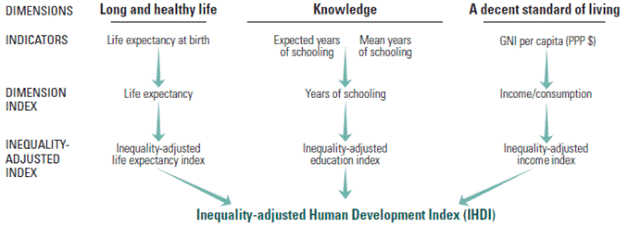[ad_1]

Introduction:
The ultimate aim of economic and social policy is to improve the lives of people, and to enhance their choices and capabilities.
Since measuring human progress facilitates this goal, it has been an abiding interest of all.
Human Development Reports since 1990. Measurement is a challenging task, however, fraught with myriad statistical and real-world complexities.
The first global Human Development Report in 1990 presented the human development index (HDI) as an alternative to gross domestic product (GDP).
Reality of Indian Median Income levels:
We are all familiar with the economic hardship of many Indians, the figures tell us how deep this issue is.
- Even before the pandemic, the median household income in India was Rs 15,000 per month.
- That means a family of four at the median income level lived on just Rs 125 per day per person for all their expenditure on food, clothing, housing, healthcare, festivals and more.
- Half of India lives with less than that. It isn’t a surprise that one health emergency can crush an entire family economically even at the median income level and this happens to fellow citizens in our country every day.
- The bottom 25 percent of households (about 300 million people in India) lived on an income of less than Rs 8,500 per month or Rs 70 per day per person.
- For the bottom 10 percent these numbers are even more gut-wrenching. And these numbers do not account for the economic devastation that the pandemic has caused. This reality is visible, but often not noticed.
- None of these numbers capture stark inequities and injustices across gender, caste, regions, and more.
Beyond GDP: Are there better ways to measure well-being?
- The creation of the HDI emerged from the tension between two approaches:
- One, seeking to develop a statistically pure, scientifically perfect measure, and
- The other, looking for a less pure, but effective measure, especially relevant to advocacy and policy-making.
- HDI became a measure of human progress more related to the lives of people. As eloquently expressed by Robert Kennedy, GDP “measures everything … except what makes life worthwhile.
- The HDI has been a useful tool of analysis for governments, the media and civil society, who employ it to evaluate and contrast human development achievements across nations, regions and groups, and over time.
- There has been variety and diversity of different views of the world of the tremendous potential and success technology has brought to our lives and the tremendous deprivation and inequity that still exists all around us.
In an economy with well-being at its heart, economic growth will simply be another tool and GDP will cease to take the center stage.
The focus would instead shift towards more desirable and actual determinants of welfare.
Today, India must commit to itself that the HDP growth rate become higher than the GDP growth rate.
Therefore, Experts propose that HDP consist of five parameters:
- First, the female labour force participation rate. Depending on what definition you look at, currently this number is 11 per cent or 22 per cent. It is shockingly low.
- The empowerment of women through their economic independence is central to human development.
- Second, gender income parity: A comparison of both, the median and the 75th percentile, of wages of men and women.
- There is no point in more women participating in the labour force if we continue to give them insecure and lower-paying jobs than men.
- Third, stunting. Stunting amongst children is about 35 per cent.
- This number reflects many things directly, for instance, the state of our public health, the nutritional status of our people, and environmental conditions.
- Fourth, water quality and availability.
- This is more difficult to measure, but tracking a few important indicators can suggest the national trends.
- So, there are suggestions that we measure the quality and flow of 10 key rivers at specified geographical points and periodicity, as well as measure groundwater levels and quality in some of the most stressed areas. All this could give us an aggregate water health index.
- Fifth, the quality of polity. For this, we can measure the percentage of members of all our legislatures, state legislatures and Parliament against whom criminal cases are pending or have convictions.
The center of Amartya Sen’s vision is ‘capability approach’, where the basic concern of human development is ‘our capability to lead the kind of lives we have reason to value’, rather than the usual concentration on rising GDP, technical progress, or industrialization.
Raising human capability is good because it improves: the choices, wellbeing, and freedom of people; their role in influencing social change; and their role in influencing economic production.
A full picture of human development may require going beyond the dimensions of the HDI and the new family of indices.
Conclusion:
“At present, we are stealing the future, selling it in the present, and calling it GDP.” — Paul Hawken.
The current approach provides information on three different but interrelated aspects of human development: the average condition of people; levels of inequality; and levels of absolute deprivation.
Achievements may need to be qualified by unsustainable production and consumption patterns, and the disempowerment of large groups of people around the world, among other factors.
The frontier for measuring human progress has expanded through the introduction of subjective measures of well-being.
The main challenge now is to improve their measurement (including their representativeness and data quality) and to understand the linkages with objective measures.
Subjective well-being indicators could be viewed as complementary measures to monitor ‘social cohesion and atmosphere’, formed by people’s emotional responses, and sense of satisfaction in general and across different domains of life.
[ad_2]

